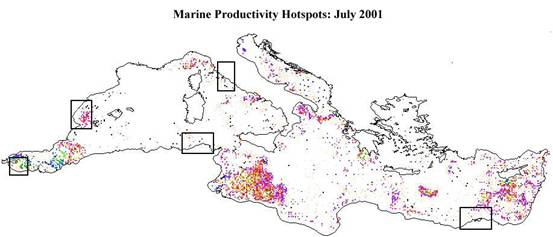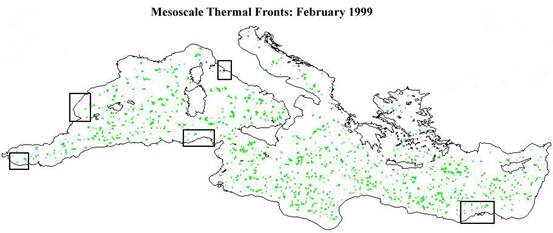Coastal waters quality: comparisons between sites
Author: Vasilis Valavanis, MSc (Partner 5)
Marine productivity hotspots (MPH) are areas of persistent and simultaneous anomalies of below-average sea surface temperature distribution (SST) and above-average sea surface chlorophyll-a concentration (Chl-a). MPH were produced from a time-series of AVHRR and SeaWiFS images that were processed for the production of climatology and anomaly distributions in both environmental parameters (Fig. 1.). MPH distribution in MEDCORE study sites is generally high throughout the year with a relative peak in late spring/early summer. This may be attributed to increased river runoff input to offshore areas that are also influenced by certain oceanic processes (e.g. seasonal upwelling and cyclonic/anticyclonic gyre formations).

Fig. 1. Distribution of persistent marine productivity hotspots in the Mediterranean during July 2001. MEDCORE offshore areas are characterized by productive gyre formations (Morocco and Egypt) and upwelling events (Spain, Tunisia and Italy).
Mesoscale thermal fronts (MTF) are areas of abrupt thermal discontinuities in the distribution of SST. MTF were produced using an automated edge-detection algorithm (the ‘sink’ method) that identifies sink pixels in SST lattice data arrays. Sink areas are sets of spatially connected cells whose flow direction out of each cell cannot be determined. These cells describe areas of heterogeneous drop in SST distribution as this is compared to more homogeneous SST distribution in the surrounding area. The computation of flow is based on a 3x3 window algorithm that assigns specific out-of-cell flow direction values for each cell based on the SST values of its eight neighboring cells. A sink is a cell or set of spatially connected cells whose flow direction cannot be assigned one of the eight valid values in a flow direction grid. This can occur when values in all neighbouring cells are higher than that of the processing cell or when two cells flow into each other. Sinks are considered to have undefined flow direction and are assigned a value that is the sum of their possible directions. Mapped thermal fronts are shown in Fig. 2. The number of MTF in MEDCORE study sites is generally high throughout the year with a relative decrease during summer. This may be attributed to the seasonal mixing of surface water masses and the general weak stratification during summer as opposed to strong stratification during winter (due to generally stronger summer wind energy that results in stronger stratification later in winter).

Fig. 2. Distribution of transient mesoscale thermal fronts in the Mediterranean during February 2001. MEDCORE offshore areas belong to a relatively short continental shelf that, along with the general surface water circulation, produces productive coastal and shelf-break thermal fronts.
REFERENCES
Valavanis VD, Kapantagakis A, Katara I, Palialexis A (2004a). Critical regions: A GIS-based model of marine productivity hotspots. Aquatic Sciences 66(1), 139-148.
Valavanis VD, Katara I, Palialexis A (2004b). Identification of mesoscale thermal fronts using satellite imagery and GIS. Journal of Marine Systems (in press).
Ultimo aggiornamento
07.08.2024

